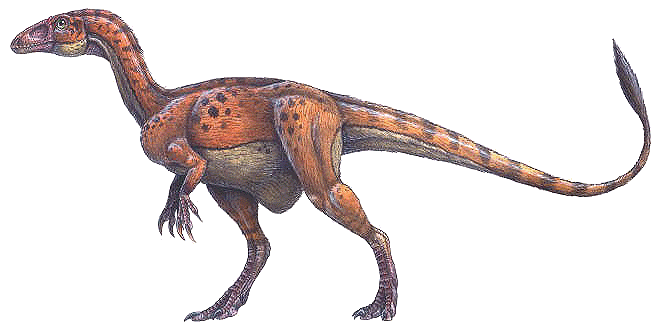Sinosauropteryx means "Chinese Reptilian Wing" and is one of the most primtive genus of dinosaurs found with impressions of feathers. This dinosaur lived in the late Jurassic period to early Cretaceous period (121-135 million years ago). Sinosauropteryx prima was found in 1996 in Sihetun, Liaoning Province, China, in an ancient lake bed. Sinosauropteryx is the earliest bird-like dinosaur.
Sinosauropteryx is the first dinosaur fossil ever found that showed evidence of having feathers. This fossils was not a bird because could not fly; its feathers were probably used for insulation, keeping the dinosaur warm.
Description
- the Sinosauropteryx prima is the smallest known non-avain theropods
- it length is 68 cm (2.2ft), largest ever found measured 98cm (3ft)
- it has a long tail
- some distinguishable features include having a skull longer than upper leg bone ( femur), very short forelimbs (30% length of legs)
-bipedal and carnivorous
- had 64 vertebrae in it tail
- large fingers with its second finger and claw being longer than the etire lower arm in radius
- weighed about 5.5 pounds (2.5 kg).
- the longest feather-filaments were 1.5 inches long (3.8 cm)
- Each egg measured 36 millimeters (1.4 inch) long by 26 mm (1 in) wide. The total length of this individual was 1.07 m (3.5 ft).
-Three complete skeletons of Sinosauropteryx have been found, including trace fossils of small fibers (protofeathers), stomach contents, unlaid eggs, and some internal organs.
-The existence of Sinosauropteryx lends credence to the theory that the birds are descended from theropod dinosaurs and not from four-legged arboreal (tree living) reptiles.
- a specimen labeled NIGP 127587 had remains of lizard in its stomach which shows that Sinosauropteryx prima preyed on fast moving creatures
 - another sample GMV 2124 (Sinosauropteryx? sp.) found three mammal jaws in its stomach region which two of these jaws belong to Zhangheotherium and the third to Sinobaatar. Zhangheotherium is known to have had a venom-secreting spur, like the modern platypus, which indicated that Sinosauropteryx prima eat venomous mammals
- another sample GMV 2124 (Sinosauropteryx? sp.) found three mammal jaws in its stomach region which two of these jaws belong to Zhangheotherium and the third to Sinobaatar. Zhangheotherium is known to have had a venom-secreting spur, like the modern platypus, which indicated that Sinosauropteryx prima eat venomous mammalsTimeline :
Archaeopteryx - The oldest known bird (150 mya) had asymmetrical feathers - it could probably fly short distances (from Germany).
Sinosauropteryx - covered with proto-feathers and with short arms (121-135 million years ago).
Protarchaeopteryx - Long, symmetrical feathers on arms and tail, but it probably could not fly (from China, 121-135 mya).
Caudipteryx - a small, very fast runner covered with primitive (symmetrical and therefore flightless) feathers. (from China, 121-135 mya)
Unenlagia - a much larger ground-dwelling theropod (from Argentina). It had flexible arm movement (up and down, like that of a bird) (90 mya).
Velociraptor - a larger, ground-dwelling carnivore from Mongolia) with a swiveling wrist bone (this type of joint is also found in birds and is necessary for flight) (85 - 80 mya).
Eoalulavis (from Spain) - the earliest bird that had good maneuverability while flying, even at low speeds (this extra flight control is obtained from a tuft of feathers on the thumb called the alula - it also helps in takeoffs and landings).
CLASSIFICATION
Sinosauropteryx belonged to the:
Kingdom Animalia (animals)
Phylum Chordata (having a hollow nerve chord ending in a brain)
Class Archosauria (diapsids with socket-set teeth, etc.)
Order Saurischia - lizard-hipped dinosaurs
Suborder Theropoda - bipedal carnivores
Infraorder Coelurosauria - lightly-built fast-running predators with hollow bones and large brains
Superfamily Maniraptoriformes - advanced coelurosaurs with a fused wrist bone
Family Compsognathidae
Genus Sinosauropteryx
Species prima (the type species).
Archaeopteryx - The oldest known bird (150 mya) had asymmetrical feathers - it could probably fly short distances (from Germany).
Sinosauropteryx - covered with proto-feathers and with short arms (121-135 million years ago).
Protarchaeopteryx - Long, symmetrical feathers on arms and tail, but it probably could not fly (from China, 121-135 mya).
Caudipteryx - a small, very fast runner covered with primitive (symmetrical and therefore flightless) feathers. (from China, 121-135 mya)
Unenlagia - a much larger ground-dwelling theropod (from Argentina). It had flexible arm movement (up and down, like that of a bird) (90 mya).
Velociraptor - a larger, ground-dwelling carnivore from Mongolia) with a swiveling wrist bone (this type of joint is also found in birds and is necessary for flight) (85 - 80 mya).
Eoalulavis (from Spain) - the earliest bird that had good maneuverability while flying, even at low speeds (this extra flight control is obtained from a tuft of feathers on the thumb called the alula - it also helps in takeoffs and landings).
CLASSIFICATION
Sinosauropteryx belonged to the:
Kingdom Animalia (animals)
Phylum Chordata (having a hollow nerve chord ending in a brain)
Class Archosauria (diapsids with socket-set teeth, etc.)
Order Saurischia - lizard-hipped dinosaurs
Suborder Theropoda - bipedal carnivores
Infraorder Coelurosauria - lightly-built fast-running predators with hollow bones and large brains
Superfamily Maniraptoriformes - advanced coelurosaurs with a fused wrist bone
Family Compsognathidae
Genus Sinosauropteryx
Species prima (the type species).


No comments:
Post a Comment